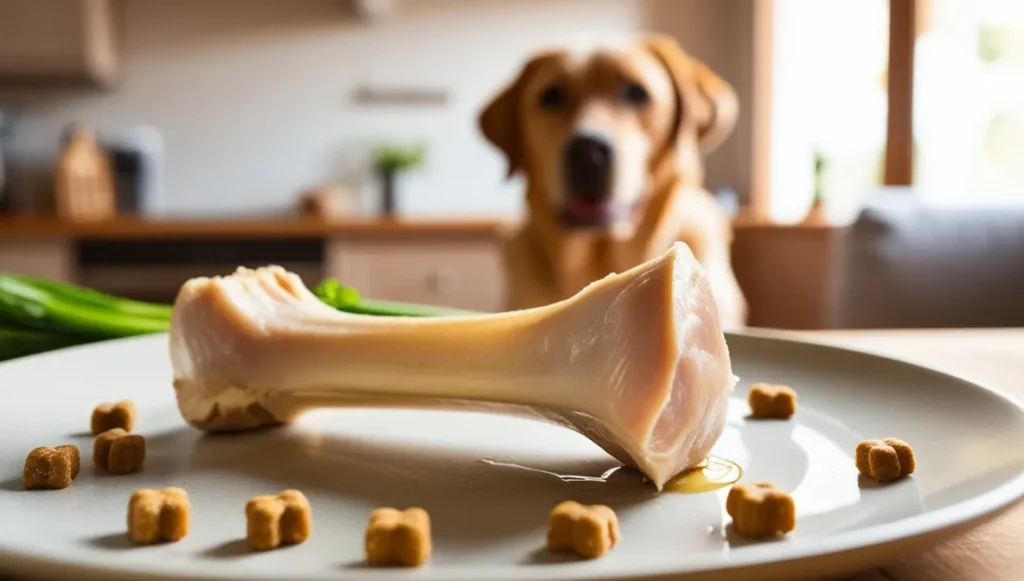Can Dogs Eat Raw Chicken Bones?: Many dog owners wonder if feeding raw chicken bones to their pets is safe. While bones are a natural part of a wild canine diet, the practice can be complex when it comes to domesticated pets. In this article, we’ll explore the risks and benefits of feeding raw chicken bones to dogs, expert veterinary advice, and safer alternatives to help you make an informed choice.
Are Raw Chicken Bones Safe for Dogs?
Understanding Raw vs. Cooked Bones
Raw bones differ significantly from cooked bones. Cooked chicken bones become brittle, splinter easily, and can pose severe risks to dogs’ digestive tracts. However, raw bones retain moisture and are less prone to splintering, which leads many pet owners to assume they’re safer. So, can dogs eat raw chicken bones? Let’s look at the evidence.
Veterinary Perspectives on Raw Chicken Bones
According to the American Kennel Club (AKC), feeding raw bones, including chicken bones, is controversial. While raw diets, like the BARF (Biologically Appropriate Raw Food) diet, advocate for feeding raw bones, veterinarians often express caution due to potential health risks.
Benefits of Raw Bones for Dogs
| Benefit | Description |
|---|---|
| Dental Health | Chewing on bones can help remove plaque and tartar from dogs’ teeth, promoting better oral hygiene. |
| Nutritional Value | Raw bones provide essential nutrients like calcium and phosphorus, which are beneficial for bone health. |
| Mental Stimulation | The act of chewing on bones can engage dogs, reducing boredom and anxiety. |
Chewing on bones can satisfy a dog’s natural instincts, potentially improving their mental and physical health.
Risks of Feeding Raw Chicken Bones
While raw bones may have some benefits, there are also notable risks. Here are some potential dangers of feeding your dog raw chicken bones:
A. Choking Hazards
Chicken bones, especially smaller bones, can pose a choking risk, especially for smaller breeds.
B. Internal Blockages
Bones can cause gastrointestinal obstructions. If pieces of bone get stuck, they may require surgical removal, which is risky and costly.
C. Bacterial Contamination
Raw chicken may contain harmful bacteria like Salmonella or Campylobacter. This can not only affect your dog’s health but may also be a risk to humans who handle the food.
D. Tooth Fractures
Although raw bones are softer than cooked bones, some parts, like the thicker chicken thigh bones, can still cause fractures in dogs’ teeth.
Also Read: Do Golden Retrievers Shed?
How to Feed Raw Chicken Bones Safely
If you choose to give your dog raw chicken bones, follow these guidelines to minimize the risks:
- Choose the Right Bone Size: Opt for larger, meatier bones like chicken wings or drumsticks that are less likely to cause choking.
- Supervise Feeding: Always monitor your dog while they chew on bones. This will allow you to intervene if any issues arise.
- Clean Handling: Practice safe food handling to avoid contamination, including thoroughly washing your hands and cleaning surfaces.
- Limit Frequency: Give bones sparingly, not as a regular diet staple, to prevent digestive issues or dependency on bones for mental stimulation.
Alternatives to Raw Chicken Bones
If you’re unsure about feeding raw chicken bones, there are safer alternatives to consider:
| Alternative | Benefits |
|---|---|
| Commercial Dental Chews | Designed to clean teeth without risk of splintering. |
| Rawhide Alternatives | Long-lasting and satisfying for dogs, though some can pose a choking hazard if not monitored. |
| Synthetic Bones | Durable options made from safe materials that mimic the chewing experience. |
| Vegetable-Based Treats | Some vegetables like carrots can be a crunchy, safe alternative to bones. |
Each alternative has its own benefits and limitations, so choose one that fits your dog’s specific needs and preferences.
FAQs
Q: Can raw chicken bones splinter?
A: Raw chicken bones are less likely to splinter than cooked bones, but they still pose a choking hazard for some dogs, especially if the bone is small.
Q: How often can I give my dog a raw bone?
A: Veterinarians recommend limiting bone intake. Offering a bone once a week is generally safe, but always consult with your vet for specific recommendations based on your dog’s health.
Q: What should I do if my dog swallows a chicken bone?
A: If your dog swallows a chicken bone, monitor them for signs of discomfort, vomiting, or distress. In cases where symptoms appear, contact your vet immediately.
Q: Are there any dog breeds that shouldn’t have bones?
A: Breeds with a predisposition to dental issues or small breeds may be more vulnerable to risks associated with bones. Consult your vet to determine if bones are appropriate for your specific dog.
Q: Can puppies have raw chicken bones?
A: Puppies have sensitive digestive systems, so it’s best to avoid feeding raw bones to young dogs, especially those under six months old.
Conclusion
The question, “Can dogs eat raw chicken bones?” does not have a straightforward answer. While raw bones can offer dental and mental benefits, they also come with serious risks, such as bacterial infections, choking, and digestive issues. Always consult your veterinarian to decide the best diet for your pet, and consider safer alternatives if you’re unsure about raw bones.
Remember, every dog is different, so what works for one may not be safe for another. By making informed decisions, you can ensure a balanced, safe diet for your furry friend.
